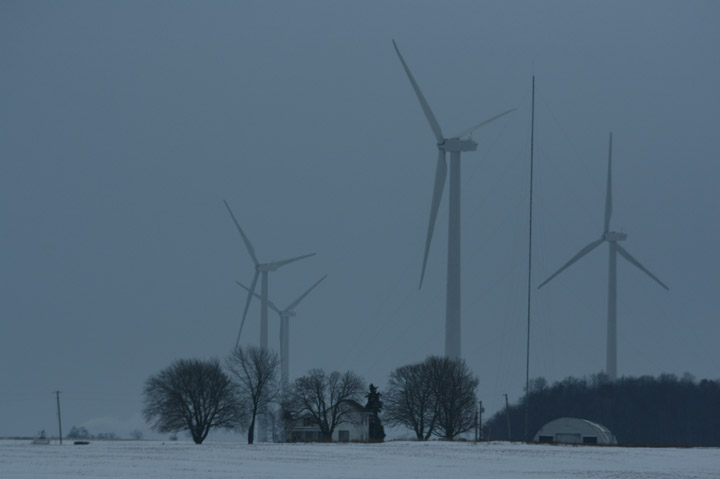Entries in wind turbine noise (103)
1/11/09 Why are residents living in the footprint of the just approved Glacier Hills wind farm worried? Ask our neighbors to the north.
Scroll down to next post to read about the Public Service Commission's Glacier Hills decision.

Wind power takes a blow around Minnesota
David Brewster
Star Tribune [source]
January 11, 2009
ELKTON, MINN. -- Every sunny morning, shadows from the massive rotating blades swing across their breakfast table. The giant towers dominate the view from their deck. Noise from the turbines fills the silence that Dolores and Rudy Jech once enjoyed on their Minnesota farm.
"Rudy and I are retired, and we like to sit out on our deck," Dolores said. "And that darned thing is right across the road from us. It's an eyesore, it's noisy, and having so many of them there's a constant hum."
Just as they are being touted as a green, economical and job-producing energy source, wind farms in Minnesota are starting to get serious blowback. Across the state, people are opposing projects worth hundreds of millions of dollars. Opposition is also rising in other states. It's not likely to blow over quickly in Minnesota, which is the nation's fourth-largest producer of wind power and on track to double its 1,805-megawatt capacity in the next couple of years.
To be sure, many people who live more than half a mile from machines are not bothered by noise, and those with turbines on their property enjoy an economic windfall. They typically sign 30-year easements and receive up to $7,500 a year for each turbine on their land.
But the Jechs do not own the land across the road, where a turbine stands about 900 feet from their 100-year-old farm home east of Austin. Flickering shadows from the 122-foot blades make east-facing rooms seem as if someone is flipping a light switch for hours at a time. "We can pull our drapes, we can put earplugs in, or we can wear dark glasses, I guess, but it doesn't really make the problem go away," said their daughter Patti Lienau.
After complaining to the developer, they received two large evergreen trees to partly block the view, and $3,000 a year to compensate for the noise. But Lienau said that no money can restore tranquility for her "shell-shocked" 85-year-old father, who struggles with panic attacks and anxiety.
"I'm not against wind. They're going to put them up whether I like it or not," said Katie Troe, leader of Safe Wind for Freeborn County. "What we're asking is that every turbine be looked at and placed correctly."
Rural area not the same
The rising numbers of complaints have taken Minnesota regulators by surprise.
"I've been doing this for 14 years and people are raising issues I've never heard of," said Larry Hartman, manager of permitting in the state's Office of Energy Security.
For the most part, said Hartman, wind farms have been welcomed by struggling farmers and revenue-hungry counties. However, some projects are drawing fire, often from non-farmers who built country homes and commute to nearby cities.
"The rural area isn't what it used to be anymore," said Kevin Hammel, a dairy farmer about 9 miles east of Rochester, where wind developers are active.
Hammel supported wind generators initially, but changed his mind after a developer took him and a busload of neighbors to visit a wind farm. The tour made him feel like he was in an industrial park, he said. Yet others admire the sleek, graceful turbines with towers up to 325 feet tall, topped by generators the size of a bus.
Federal subsidies and state mandates for utilities to produce more electricity from renewable sources are accelerating wind farm development.
The nature of noise
Minnesota regulations require that wind turbines be at least 500 feet away from a residence, and more to make sure sounds do not exceed 50 decibels. In most cases, that amounts to at least 700 to 1,000 feet, depending upon the turbine's size, model and surrounding terrain. Whether 50 decibels is too loud depends upon individuals, who perceive sound differently, but it approximates light auto traffic at 50 feet, according to wind industry reports.
Critics say setback distances should be tripled or quadrupled. Nina Pierpoint, a New York physician who has examined the issue, describes "wind turbine syndrome" with symptoms that include sleep disturbance, ear pressure, vertigo, nausea, blurred vision, panic attacks and memory problems.
Last month, the American and Canadian Wind Energy Associations released a report that reviewed those claims and said they lacked merit.
Rita Messing, a supervisor at the Minnesota Department of Health, co-wrote a report last July to help guide the state on noise decisions.
Wind turbines emit a broad spectrum of sound, she said, including higher frequencies covered by state noise regulations and lower frequency sounds that are not. Her report does not recommend changes in the state noise rules, but notes that local governments can impose longer setbacks.
That needs to happen, said Tom Schulte, who's upset about a proposed wind farm near his new home in Goodhue County. "When I built this house, the county told me where to build: how far from my neighbor, how far from a fence line, how far from a feedlot, and out of 23 acres there wasn't a whole heck of a lot of land left where I could have put a house," Schulte said. "And yet somebody can plop a 400-foot-tall turbine 500 feet from my house and the county steps back and says they don't have any say about it."
Changes ahead?
The debate over noise and setbacks will drop into St. Paul this month when the Minnesota Public Utilities Commission takes up the matter. Comments filed by 16 wind developers said the state's noise rules and setback distances do not need to be changed, that "shadow flicker" from rotating blades can be solved by better modeling and siting, and that there's no evidence that low-frequency sounds affect human health.
Others are not convinced and want Minnesota to reevaluate the rules. People who live near wind turbines are "experimental subjects, who have not given their informed consent to the risk of harm to which they may be exposed," said Per Anderson of Moorhead. He postponed plans to build a house on land near three proposed wind farms in Clay County.
Some people challenge the industry's claim that 50 decibels is no louder than light traffic or a refrigerator running. Brian Huggenvik, who owns 17 acres near a proposed wind farm 2 miles from Harmony, said he has driven to various wind farms and listened to the noise to judge for himself. Huggenvik, an airline pilot, said turbines can also produce a whining sound, similar in frequency to a jet engine idling on a taxiway, though not as loud. "It's not like living next to a highway with constant sound and your mind blocks it out," he said. "It's something that you just can't get used to. It is a different kind of sound."
Bill Grant, executive director of the Izaak Walton League's Midwest office, said that all energy sources impose certain costs and inconveniences. If there are legitimate conflicts about wind turbine noise and public health, the siting guidelines should be revised, he said.
But Grant cautioned against putting severe restrictions on a renewable industry that offers so many benefits. "What people who want to scale back wind are overlooking is the number of deaths that occur annually from air pollution from coal plants," he said.
1/10/10 Monday, Monday. The PSC decides on the fate of residents whose homes are inside of the Glacier Hills Project
WISCONSIN WIND TURBINE NOISE LOG, TOWN OF BROWNSVILLE, WI.Sunday, January 10, 2010:7:45AM. Wind SW 6 knts, 18 rpms @ 1000’ from turbine 4. dBA 51.8, dBC 67.0. Wind is low, blade speed high, low ambient sound, therefore very loud turbine sounds.Turbines 4, 6 & 73 loudest, but also I hear 3a, 74a +. My wife did not sleep well and was up several times “trying” to get tired. Two other nights this week similar happenings for her. I woke up with a headache and it continues. Again, it is rare for me to have a headache.I would guess my cortisol level is again high as the last week or so my food seems like it is in my throat and I need to keep drinking water to keep the food down. My weight is getting close to my all time high.3:50 PM Wind SW, 18.6 rpms 14 knts, peak gusts 21. The sound of the wind is now loud so it covers much of the turbine sounds even though the jet sound is still heard. My wife just asked if the wind is strong because the ringing in her ears is loud.Yes, the volume of the ringing sound varies."---Gerry Meyer, Invenergy Forward Energy wind farm resident, Fond du Lac County, Wisconsin
"Let me be clear, however, as to why I’m here. I’m here because of people who are suffering as a consequence of being near wind turbines. Adverse health effects are occurring as we speak.
My proposal is this: Authoritative guidelines must be developed, and the only way to do that is a well-designed epidemiological study conducted by arm’s length investigators, mutually agreeable to all sides. That must be done – as well as check for low frequency noise. In the meantime, let us listen to and help the victims. Anything less would be an abandonment of responsibility by government."
---Testimony of Dr. Robert McMurtry to the Ontario Legislative Assembly Standing Committee. [Click here to read more ]
 Glacier Hills Wind Farm: Yellow circles indicate 1000 setback around non-paticipating homesPSC ruling expected on Glacier Hills
Glacier Hills Wind Farm: Yellow circles indicate 1000 setback around non-paticipating homesPSC ruling expected on Glacier HillsState regulators on Monday will rule on We Energies' $413.5 million proposal to build the largest wind farm in the state.
The Milwaukee utility is proposing a 90-turbine wind power project, the Glacier Hills Wind Park, northeast of Madison. It would be the largest wind farm in the state, slightly bigger than the 88-turbine Blue Sky Green Field wind farm We Energies began operating near Fond du Lac last year.
Glacier Hills would generate enough power over a year to supply 45,000 typical homes, the utility says.
The proposal has run into opposition from local residents who are concerned about the impact of wind turbines on their property values as well as a Chicago wind-power developer that is proposing an alternative project.
We Energies needs this and other renewable energy projects to be built in order to comply with a state mandate that 10% of Wisconsin's electricity come from renewable power sources by 2015.
A provision in the proposed Clean Energy Jobs Act, introduced this week, would accelerate that mandate, requiring the utility to meet that 2015 requirement two years earlier, in 2013. The bill would require that the mandate ramp up so that 25% of the state's power supply would come from wind turbines, biomass projects and other renewable power sources by 2025.
In the Glacier Hills case, the environmental group Clean Wisconsin is calling on the Public Service Commission to require the Milwaukee utility to shut down some of its older coal-fired power plants as a way to help it comply with renewable power mandates.
Shutdowns would make it easier to attain renewable targets and may be in order, the group says, because decreasing power sales linked to the recession and the addition of power plants in Port Washington and Oak Creek mean the state no longer faces power supply challenges.
The state Public Service Commission last month agreed to open an inquiry into whether the state's utilities should have to shut down or idle older plants because of the state has an ample supply of power.
Meanwhile, Invenergy LLC of Chicago is asking that the commission, if it approves the We Energies project, also require the utility to enter into negotiations to buy power from Invenergy's proposed wind farm in southern Brown County. Invenergy built the Forward Wind Energy Center near the Horicon Marsh.
We Energies spokesman Brian Manthey said the utility believes it has made the case for Glacier Hills.
"It's definitely one of the best locations in the state to build a wind farm," Manthey said. There's a nearby link to the high-voltage transmission system, he said, and "it's a good wind resource and low population density. That all points to why this is a very, very good location."

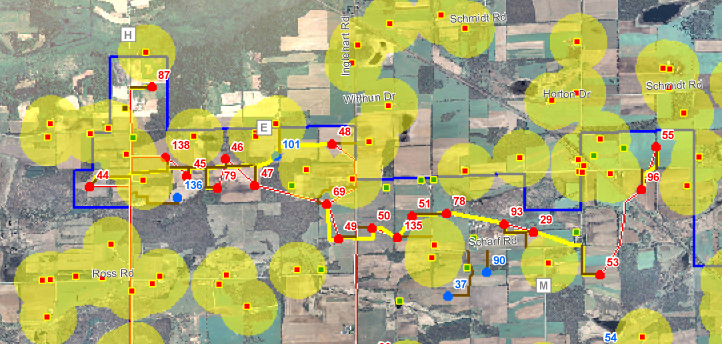
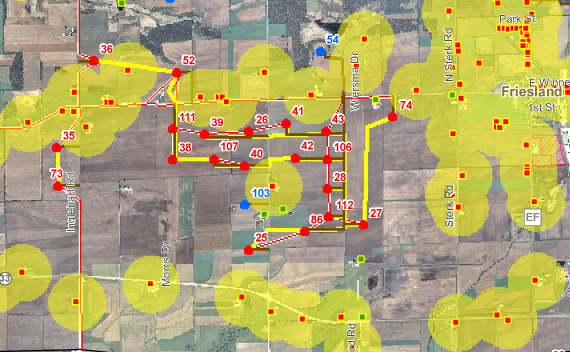

12/31/09 Cash for Wind Leases: OR "I'll give you this big nickel for that little dime"
 Golden Opportunity or Another Green Cheese Sandwich?
Golden Opportunity or Another Green Cheese Sandwich?
Some say the success of the wind industry relies on empty cupboards in rural communities.
Struggling rural families who have signed on with wind developers now have a new industry to contend with, one that will pay out a lump sum in exchange for ownership of the wind lease and all that goes with it.
It reminds us of the many 'Check-into-Cash' or 'Payday Loans' stores that appear in blighted communities.
This quote is from an organization called "Wind Farm Capital" CLICK HERE to read at source
"Get an Upfront Lump Sum Cash Payment by Selling Wind Farm Lease"
"Financial Benefits of Selling Your Wind Farm Lease to Wind Farm Capital"
"In today’s economic climate, consumers and businesses alike are feeling the impact of the credit market squeeze, and finding it virtually impossible to secure capital, regardless of their credit history.
But Wind Farm Capital can provide a quick, easy, and welcome alternative by converting your wind farm lease royalties payment into a lump sum cash payment.
We provide the cash up front; there are no loan applications to fill out, no interest payments to budget for, and best of all, no default scenarios to worry about - no matter what happens to the lease down the road. Even if your lease terminates for some reason, you owe us nothing.
With multiple years’ worth of lease payments in your hands now, your options suddenly become endless. Whether you choose to pay down your existing debt, plan for your future, or invest in the market, the reward for each is similar - a windfall that leads to greater financial freedom, security, and long-term wealth."
NOTE FROM THE BPWI RESEARCH NERD: Please consult a lawyer before you sell your wind lease to anyone.
"By 2020, Xcel Energy [formerly Florida Power and Light] plans to more than double wind capacity system-wide from 2,800 megawatts to 7,000 megawatts.
Engelking said Xcel will buy or develop 3,000 megawatts of that power for its system in Minnesota or Wisconsin. She said the utility will focus on developing wind because tax benefits reduce energy costs to consumers."
NOTE FROM THE BPWI RESEARCH NERD: Wisconsin has just over 300 industrial scale turbines at present.
This proposal from Xcel for 3,000 megawatts of wind power requires the installation of at least two thousand 1.5MW turbines. Each turbine is close to 40 stories tall.
Xcel is not the only developer planning projects in our state. In order to meet the Governor's Task Force on Global warming recommendations, at least 14,000 more turbines need to be sited.
AND THE TURBINES JUST KEEP GETTING BIGGER
A new wind farm planned for the Town of Glenmore in Brown County calls for turbines 500 feet tall, or as tall as a 50 story building. This will make them the tallest structures in the state of Wisconsin.
WHO WILL OWN THE BROWN COUNTY WIND FARM?
WHO IS 'EMERGING ENERGIES OF WISCONSIN?'
"The CH Energy Group, owner of the New York utility Central Hudson Gas & Electric Corporation, holds a controlling interest in the project via its unregulated subsidiary Central Hudson Enterprises."
12/28/09 UPDATE on yesterday's turbine collapse: Another One Bites the Dust: What made turbine # 18 collapse?
Click on image below to watch an updated news report on the turbine collapse at the Fenner wind farm.
Turbine collapse draws concern from other proposed project areas
FENNER, N.Y. (WKTV) - Local residents are wondering if one wind turbine could collapse in Madison County, then it is very possible for a turbine to fall anywhere.
Fairfield resident Jim Salamone thinks why couldn't it happen in his back yard.
Salamone, who is opposed to the proposed wind turbine projects in Fairfield says he was not surprised when he woke up to find out a wind turbine had collapsed in Fenner. He says the meteorological tower that used to be right across from his home already collapsed because of wind and ice.
Meteorological towers are used to measure wind in areas where developers want to put turbines. Salamone says the meteorological tower that collapsed near his home was the third one to do so in as many years.
Salamone says he wonders if those towers can collapse so easily, and if a tall turbine can also collapse how safe is his property living so close to a proposed site.
"They must be 1250 feet from your house, 500 feet from the road. So if a 476 foot wind turbine comes down 500 feet from the road that is only going to leave you, what 24 feet (that) if the blade breaks that is has to travel before it could go through your car." said Salamone.
Salamone says he is not opposed to a wind turbine project if they are put in the right place, but he says the rolling hills near most homes in Fairfield, is not the right location for large turbines.
TURBINE FALLS AT FENNER WIND FARM
WSYR-TV [Click here to read at source and watch news clip]
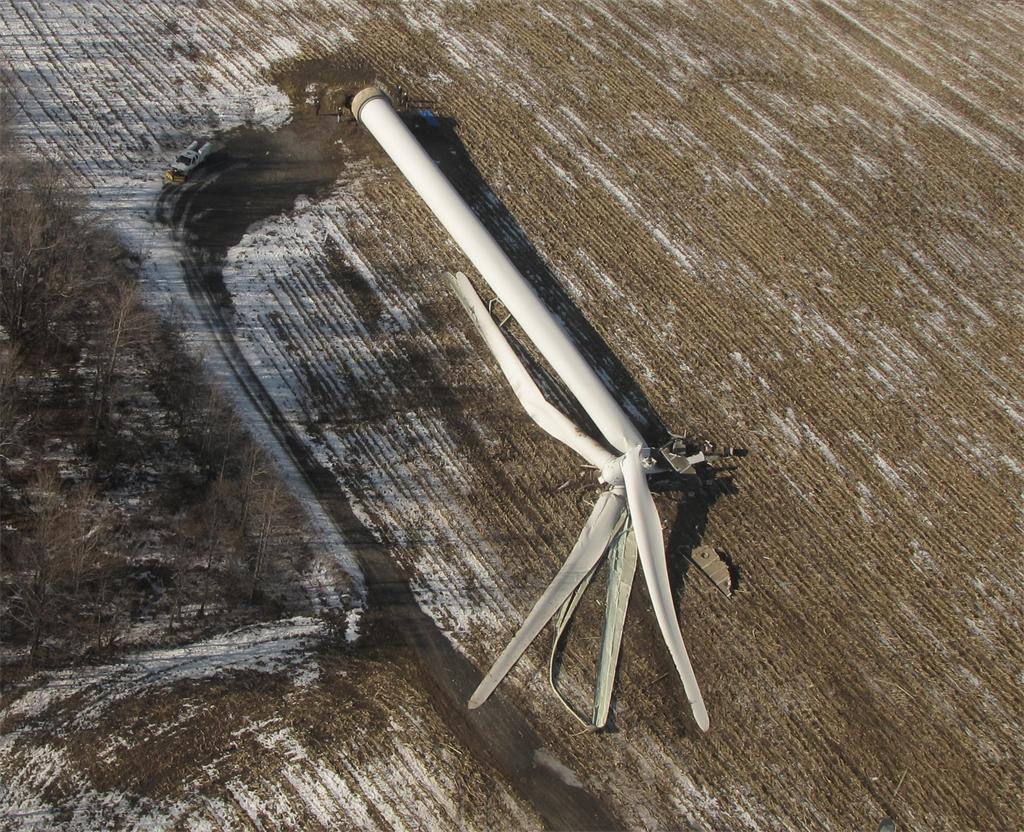
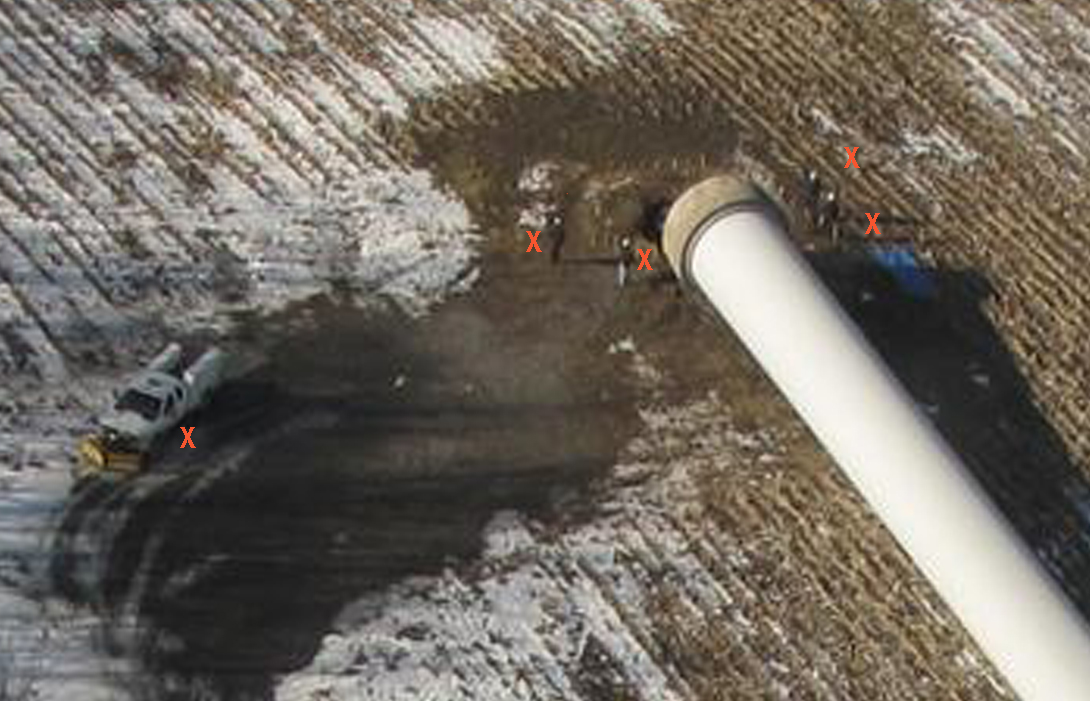
Fenner, Madison County (WSYR-TV) – A turbine at the Fenner wind farm has toppled, and engineers are on the scene trying to figure out how it happened.
The tower, which is more than 300 feet long from the base to the tip of the blade, is located just off Buyea Road, and is one of 20 generating electricity.
"I was turning over in bed and it sounded like a big clap of thunder" said Jill Van Allen, who lives across the street. "I was waiting to see the lightning through my bedroom window (but didn't)".
Fenner Town Supervisor Russ Cary was notified by company officials at Enel North America, which owns the farm. He tells us Enel did not have any answers as to how it happened, but adds, the towers were built a distance away from homes for this very reason-that if they collapse, they won't do any harm.
From another news story:
Officials investigating why 187 ton windmill collapsed in Fenner
QUOTE: "Bob Stinson, a resident of South Road nearly two miles from Turbine 18, said it sounded like "a sonic boom" when the windmill toppled.
"I felt it. It shook the house. It woke me up," Stinson said."
READ ENTIRE STORY BY CLICKING HERE
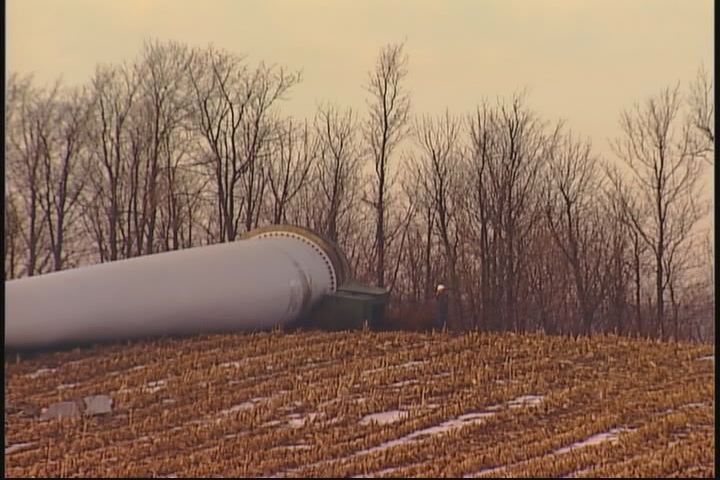
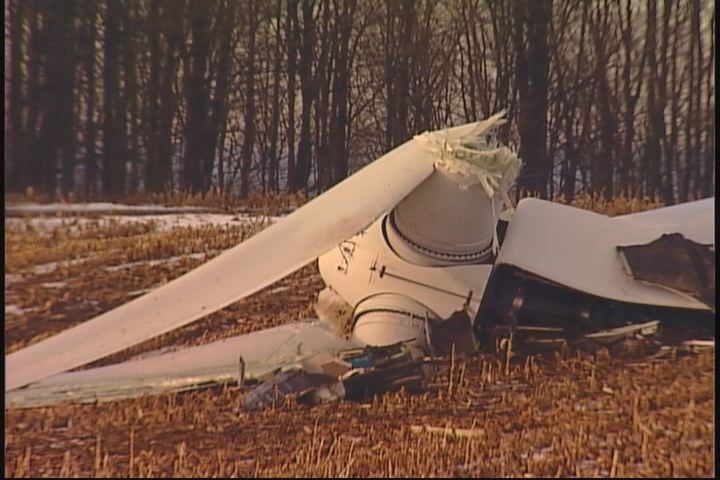
12/27/09 What is the effect of a wind farm on property values? A tale of two studies and a story problem
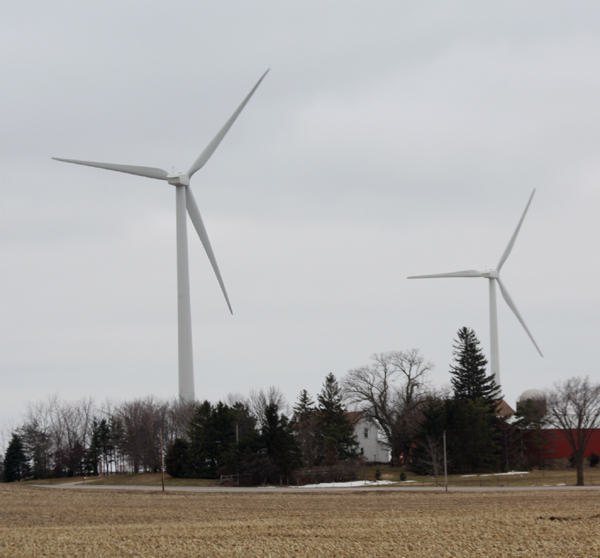
Turbine impact studies conflict
PROPERTY VALUES: Local opponents say wind farms harmful
Opponents of wind farm development in Jefferson County have touted property value decline as a possible harm.
But that argument, or any counterclaim, is getting little support from experts. Two studies on property values around wind farms were released in 2009, but had very different results.
The U.S. Department of Energy's Lawrence Berkeley National Laboratory supported a study that found no measurable value loss linked to wind farms in sales data from 7,459 sales of single-family homes within 10 miles of 24 wind farms in nine states.
Meanwhile, Appraisal Group One, Oshkosh, Wis., conducted a smaller study of vacant land sales in and around two wind farms for the Calumet County Citizens for Responsible Energy this year. In a year where property values suffered nationally, that study found the average loss in value at 40 percent in one wind project's area and 30 percent in the other.The Energy Department study, led by Ben Hoen, looked at home sales from 1996 to 2007. It compared the characteristics of the homes in several models.
"Specifically, neither the view of the wind facilities nor the distance of the home to those facilities is found to have any consistent, measurable and statistically significant effect on home sales prices," the report said.
The number of transactions, which included 125 within a mile after construction and about 60 within 3,000 feet, decreased the margin of error.
"It was more data than had been collected before," Mr. Hoen said. "We tried a lot of different ways of testing the data. It's the most complete analysis of the subject to date."
But Kurt C. Kielisch, president of Appraisal Group One, said the sheer number of sales included in the Energy Department study may have clouded the results.
"You can lose the distinction in numbers," he said. "You only need 20 to 30 good sales for a very good study."
His appraisal firm's study included sales of 12 vacant parcels inside two wind projects' boundaries and 90 vacant parcels outside the boundaries. All of the parcels were within one-half mile of turbines and had a view of them.
"It is logical to conclude that the factors that created the negative influence on vacant land are the same factors that will impact the improved property values," the study said. "Therefore, it is not a leap of logic to conclude that the impact of wind turbines to improved property value would also be negative."
Mr. Hoen said the Energy Department study has its advantage in the high number of sales included.
"In other studies the effect exists based on the surveys of Realtors," he said. "In our study, we concentrated only on actual transactions."
Appraisal Group One did include a survey of real estate agents. Mr. Kielisch argued that the results tracked very closely with his sales data.
"Every appraiser gets opinions from Realtors," Mr. Kielisch said. "They are in the trenches and we are the observers."
The survey asked about property value on parcels within 600 feet, 1,000 feet and one-half mile of the turbines. The agents agreed there would be lost value for all the lots, vacant or improved. How much, between 24 percent and 43 percent, depended on the distance.
Based on his results, Mr. Kielisch suggested that property owners ask for a property value assurance agreement, where a developer would pay the difference between a property's sale price and the value of comparable property outside of a wind power development if the property loses value.
"If you really believe that the value won't decline, guarantee that fact," he said.
Both researchers agreed future studies should include some data on how long properties are on the market. Other areas to consider include whether secondary residences and certain scenic vistas are more sensitive, Mr. Hoen said.
NOTE FROM THE BPWI RESEARCH NERD:
Story Problem: If the DOE report used sales data from 7,459 sales of single-family homes within 10 miles of 24 wind farms in nine states, and 125 of those homes were within a mile of the wind farm after construction and about 60 of those were within 3,000 feet, what percentage of the homes in this study are located within one mile of a wind farm?
ANSWER: 1.67 %
Extra Credit: What percentage of the homes in this study were located within 3000 feet?
ANSWER: 0.8 %
Extra extra credit: What is the setback from a home in Wisconsin?
ANSWER: 1000 feet or less.

